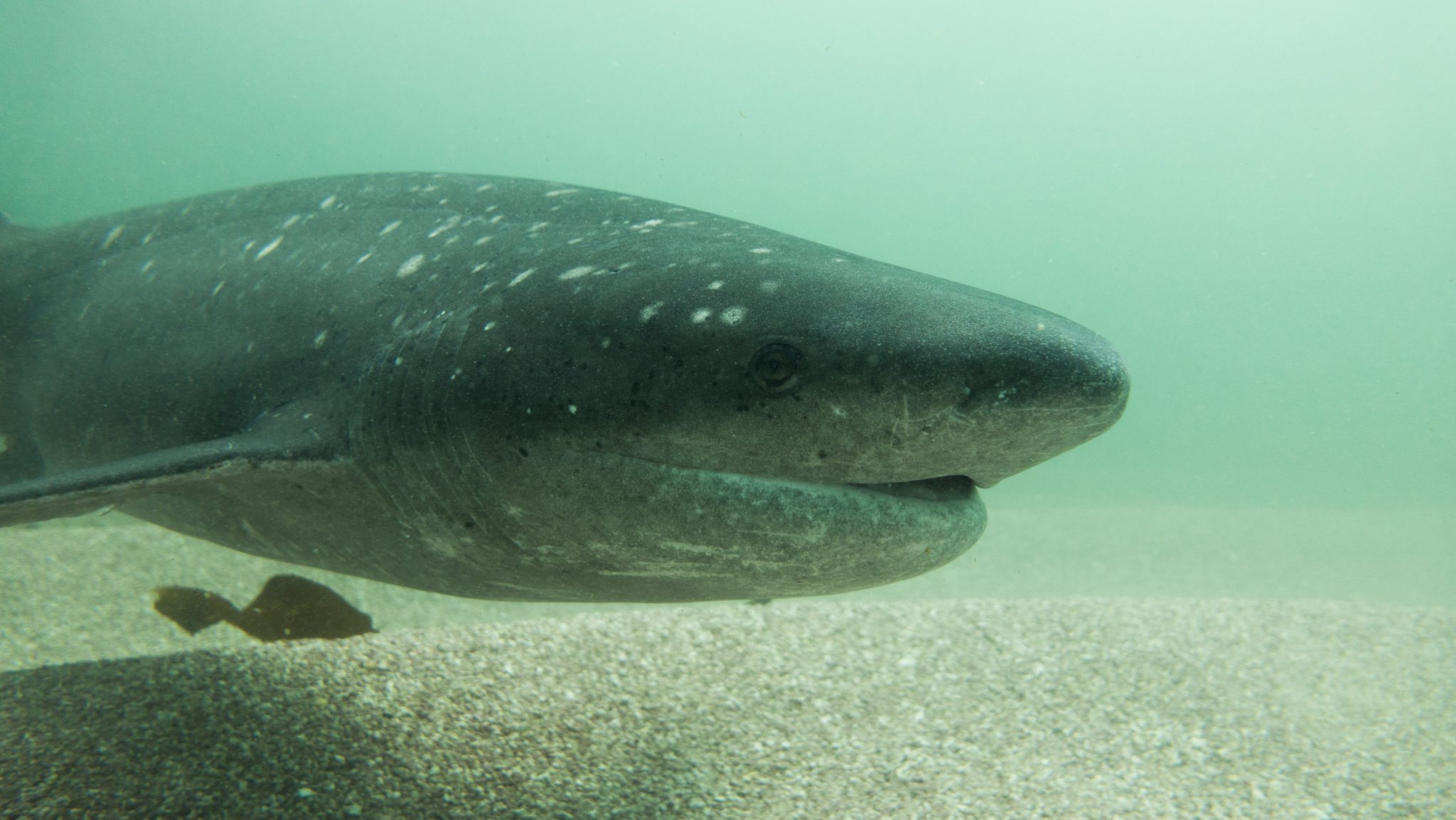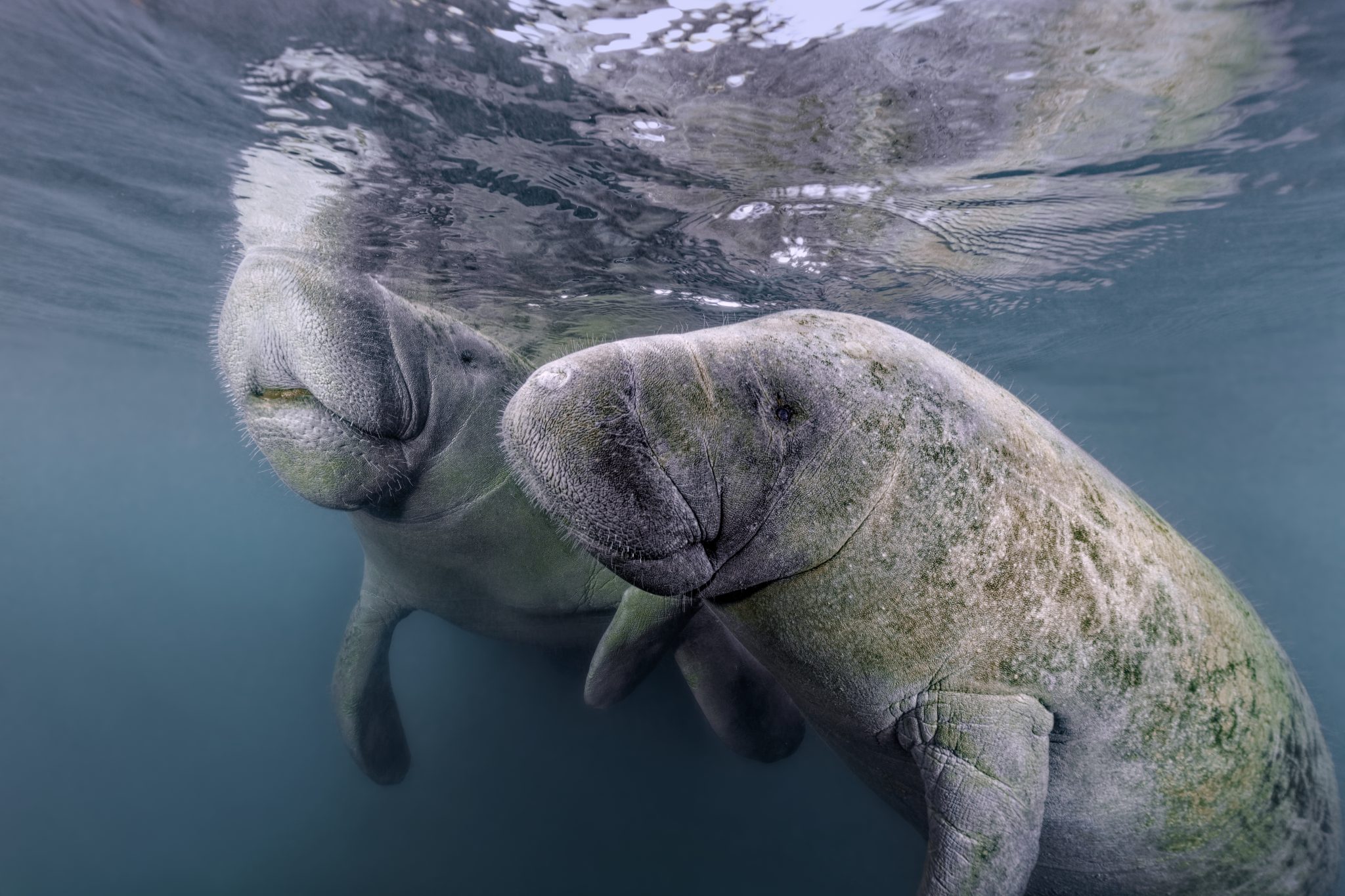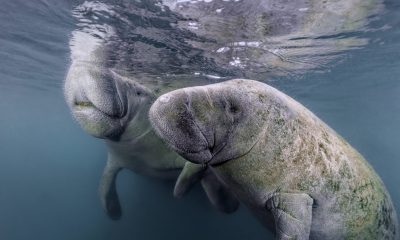Marine Life & Conservation Blogs
Creature Feature: Broadnose Sevengill Shark

 In this series, the Shark Trust will be sharing amazing facts about different species of sharks and what you can do to help protect them.
In this series, the Shark Trust will be sharing amazing facts about different species of sharks and what you can do to help protect them.
Written by guest contributor – Yolanda Evans.
A small glimpse of grey amongst the the vibrant green of the kelp around the temperate coastal waters could be no other then the incredible Broadnose Sevengill shark! Hinted by their common name, these sharks have seven pairs of gill slits – unlike the typical five. These sharks can reach up to 3 metres long and are commonly misidentified as the other species of sevengill the Sharpnose Sevengill. The Broadnose is distinguished by small black and white freckles on their fins and underside and a much larger head then the Sharpnose.
Unlike many other sharks in the Hexanidae family (Cowsharks), this species prefers waters of less then 50 m in depth; sometimes being found in river estuaries where the depth is around 1m! However, Brodnose’s make seasonal migration during the winter to the continental shelves, following their food and sexually mature females.
Broadnose Sevengill’s have a unique tooth shape in their lower jaws: they are shaped like combs which they use to anchor into their prey. This sharks favourite snacks large fish (including other sharks) and crustaceans but they have been videoed eating carrion (dead/decaying bodies), making them scavengers. There are even reports of cannibalism as the older sharks eat the younger to reduce competition. Once they’ve eaten a meal they wont have to eat again for weeks, in fact, in a month they only consume 6% of their body weight!
Predominantly being a solitary shark, they do sometimes congregate in groups to hunt. They mainly do this to get to bigger prey which could be too much work for a single shark. Stalking behind their prey, these sevengill’s will then rapidly burst out to chase down their prey.
Sevengill’ are ovoviviparous and can give birth to 60-180 pups, an incredibly high amount. The pups remain in the shallow waters until they reach a certain size to help avoid predators.
Recent carcasses of these sevengill’s have been found worldwide, all with their livers missing. Who could be behind this series of surgically-precise murders other then the infamous Orca. Orca, or Killer Whales,purposefully seek out Broadnose Sevengill sharks for their livers rich in fats, making a high calorie snack for these mammals. The Orca turn the shark over on their backs, putting them in a state of tonic immobility, and then using their sharp conical teeth they precisely remove the liver leaving the rest of the shark as it doesn’t have the same nutritional value. However, a few videos have emerged of these Orcas then playing with their food, pushing the dead sharks body up and down with their snouts!
Orca’s aren’t the only mammal to purposefully hunt down these sharks as the Broadnose Sevengill’s are also targeted by humans for their meat, skin for leather, and their oil, however, their main threat is being caught as by-catch during industrial fishing. The IUCN lists them as Data Deficient, however, it is expected that they are Near Threatened.
SCIENTIFIC NAME: Notorynchus cepedianus
FAMILY: Hexanchidae
MAXIMUM SIZE: Up to 3.3 meters (10.8 feet) in length
DIET: Feeds on a variety of prey including fish, squid, crustaceans, and even other sharks
DISTRIBUTION: Broadnose Sevengill Sharks have a cosmopolitan distribution, found in coastal and offshore waters in temperate and tropical regions worldwide.
HABITAT: Found in a variety of habitats, including estuaries, bays, and shallow reefs, as well as deeper waters of up to 150 meters (492 feet) in depth.
CONSERVATION STATUS:
While there is little data on population trends, this species is known to be caught as bycatch in some commercial and recreational fisheries, and there is also concern over the impact of habitat loss and degradation on their populations.
For more great shark information and conservation visit the Shark Trust Website
Banner image – Aaron Scheiner | Wikimedia Commons
In-text Image – derekkeats | Wikimedia Commons
In-text Image – Coco | Wikimedia Commons
Blogs
Heading out on the water this Summer? Watch for manatees

As National Safe Boating Week approaches, Save the Manatee® Club is urging boaters, and anyone that enjoys Florida’s waterways, to respect and protect the defenseless manatees that inhabit our shared waterways. From May 18 to 24, leading up to Memorial Day Weekend, the campaign aims to raise awareness about recreational boating safety and the importance of safeguarding imperiled manatees during the summer boating season. This week also emphasizes the importance of encouraging boaters to enroll in a boating safety course.
Manatees are semi-migratory marine mammals that are commonly found in shallow estuaries, bays, rivers, canals, and coastal areas throughout Florida and neighboring states. With some manatees venturing as far west as Texas and as far north as Massachusetts, collisions between these gentle giants and watercraft have become distressingly frequent. Boat propellers and high-speed collisions pose significant threats to manatees, often resulting in severe injuries or even death.
Save the Manatee Club is calling on all water enthusiasts to follow essential manatee safety tips to ensure the well-being of the imperiled manatee:
- Obey Speed Zone Signs: Familiarize yourself with and adhere to posted speed limits to prevent collisions with manatees.
- Reduce Glare with Polarized Sunglasses: Wear polarized sunglasses to enhance visibility and spot manatees below the water’s surface.
- Recognize Manatee Signs: Learn to identify signs of manatees in the area, such as swirls or flat spots on the water caused by their movements.
- Respect Manatee Sanctuaries: Keep a safe distance from posted manatee sanctuaries and avoid pursuing or harassing these marine mammals, as it is illegal and can disrupt their natural behaviors.
- Report Distressed Manatees: In Florida, promptly report distressed, injured, tagged, or orphaned manatees to the Florida Fish and Wildlife Conservation Commission (FWC) at 1-888-404-FWCC (3922). Outside of Florida, report sightings to the appropriate state agency or rescue organization. A list of agencies to contact is available at savethemanatee.org/report.
- Protect Seagrass Beds: Avoid boating over seagrass beds and shallow areas where manatees may be feeding. Stick to deep water channels while remaining vigilant, as manatees also utilize these channels during their travels.
- Dispose of Fishing Line Responsibly: Anglers should properly dispose of or recycle used fishing line to prevent entanglement hazards for manatees.
“Each year, National Safe Boating Week provides an excellent reminder for all of us to be aware that we share our waterways with vulnerable manatees,” emphasized Patrick Rose, Aquatic Biologist and Executive Director of Save the Manatee Club. “With the recent Unusual Mortality Event on Florida’s East Coast claiming an alarming number of manatees’ lives, it is more crucial than ever to prevent preventable deaths caused by watercraft collisions. By following manatee-safe boating guidelines, such as obeying speed zones and remaining vigilant for manatees, everyone on the water can contribute to the protection of these gentle giants.”
Save the Manatee Club offers a range of free materials to help safeguard manatees and raise awareness about manatee-safe boating practices. Shoreline property owners and park or marina managers can order aluminum dock signs to alert others about the presence of manatees in their areas. Boaters and paddlers can request packets containing a safety tips card, a waterproof boat banner, and a decal to display on their vessels, providing the number to report manatees in distress. To view and request these materials, visit savethemanatee.org/resources. Save the Manatee Club will also be hosting a live webinar for National Safe Boating Week on Tuesday, May 21st at 6pm EST. To register, visit savethemanatee.org/register.
Marine Life & Conservation Blogs
Book Review: Shells of the World

Shells of the World: A Natural History by M.G. Harasewych
Shells of the world is a guide to the world of marine, shelled molluscs. And what a varied and interesting world it is. Some of my favourite things to find on a dive are detailed in this book, including disco clams (or Electric File Clams as they are correctly names), the cephalopods, giant clams and sea hares. There are also many on my wish list, top of which is the Nautilus.
Each chapter provides a detailed description of the species, along with beautiful images. You can dive deeper and discover where they live, both with global distribution and the habitat they prefer. Learn about their diet, reproduction and diversity.
Having dipped in and out of this lovely book over the past few weeks, it has inspired me to learn more about this group of animals that we see on most divers, wherever we are in the world. Some of the shells are incredibly intricate and beautiful. I have always agreed with never collecting, or touching, marine life. The description of a certain set of cone shells should be a warning to those that are happy to pick up marine life! One of the cone shells has a local name called the cigarette snail. Why? Because once the venom is in your system from this animal, you only have time to smoke one cigarette before the affects of the venom are fatal!
What the publisher says:
Mollusks are invertebrate animals with a remarkable natural history and a rich fossil record, and their shells are prized for their breathtaking variety and exquisite beauty. Shells of the World provides a wide-ranging look at the incredible diversity of marine mollusks. An informative introduction outlines the lineages covered, followed by a directory section, split into classes, that profiles a broad selection of different taxa to give a sense of their sheer numbers and variety.
- Features hundreds of beautiful color photos, depicting both the live animals and their shells
- Discusses mollusk evolution, anatomy, life cycles, behavior, and ecology
- Describes unique characteristics, distribution, habitat, and size
- Provides valuable insights into the conservation of the world’s marine mollusks
- Ideal for malacologists and shell collectors everywhere
About the Author:
M. G. Harasewych is research zoologist emeritus and former curator in the Department of Invertebrate Zoology at the Smithsonian Institution’s National Museum of Natural History. A fellow of the American Association for the Advancement of Science, he is the author (with Fabio Moretzsohn) of The Book of Shells: A Life-Size Guide to Identifying and Classifying Six Hundred Seashells.
Book Details
Publisher: Princeton University Press
Hardcover
Price: £25
ISBN: 9780691248271
Published: 9th April, 2024
-

 Marine Life & Conservation Blogs3 months ago
Marine Life & Conservation Blogs3 months agoCreature Feature: Swell Sharks
-

 Gear Reviews4 weeks ago
Gear Reviews4 weeks agoGEAR REVIEW – Revolutionising Diving Comfort: The Sharkskin T2 Chillproof Suit
-

 Blogs2 months ago
Blogs2 months agoMurex Resorts: Passport to Paradise!
-

 Blogs3 months ago
Blogs3 months agoDiver Discovering Whale Skeletons Beneath Ice Judged World’s Best Underwater Photograph
-

 News3 months ago
News3 months agoPADI Teams Up with Wellness Brand Neuro to Drive Ocean Change and Create a Blue State of Mind
-

 Marine Life & Conservation2 months ago
Marine Life & Conservation2 months agoSave the Manatee Club launches brand new webcams at Silver Springs State Park, Florida
-

 Blogs2 months ago
Blogs2 months agoSeagrass Awareness Month brings critical food source for Manatees to centre stage
-

 Blogs1 month ago
Blogs1 month agoSOMABAY: Scubaverse interviews Wolfgang Clausen, General Manager, ORCA Dive Clubs


















